Tenancy Deposit Scheme: review
Results from research with tenants, landlords and schemes as part of a review of the Tenancy Deposit Scheme in Scotland.
Surveys of tenants and landlords
Methodology
Both the tenant and landlord surveys were administered online, using Survey Monkey and Questback respectively. In both cases, the tenancy deposit schemes sent out invitation emails to tenants and landlords, which contained a link to access the survey. The tenant survey was also advertised through various tenant networks to encourage response from particular groups, and prize draw to win one of five £50 vouchers was offered. The landlord survey was sent only to landlords that deal with the schemes themselves, and not to letting agents who may represent landlords.
Questionnaire design
The tenant survey was designed in conjunction with Craigforth and administered first. Fieldwork ran from 1st March to 13th April 2018. The questionnaire asked tenants three types of questions;
- General questions about themselves, their household and their knowledge and awareness
- Questions that related to their current tenancy
- Questions that related to a tenancy that had ended in the last three years (if applicable)
Upon completion of fieldwork, the tenant questionnaire was reviewed and used as a base for the landlord questionnaire. Landlords were also asked three categories of questions as shown above, and fieldwork ran from 7th May to 18th June 2018. The full questionnaires are included in Annex C.
Sampling, response rates and weighting
The surveys were sent out to every tenant and landlord who had, at the time of the survey, a deposit lodged with one of the tenancy deposit schemes, and thus no sample selection was required. The survey was sent to 232,411 tenants, and achieved 7969 completed interviews - a response rate of 3.4%. The landlord survey was sent to approximately 42,598 landlords and achieved 1087 completed interviews - a response rate of 2.5%.
The results of the tenant survey were weighted to be representative of household type and geographical spread, please see Annex A for more information. The landlord survey results have not been weighted, due to a lack of suitable population data.
Limitations of the surveys
The methodology was chosen as the most cost effective way to access tenants and landlords and to achieve a sufficient number of responses for both tenants and landlords. However, this methodology does mean there are limitations for the results of the research.
Sampling
As the surveys were issued through the deposit schemes themselves, we cannot use the results to assess the extent to which deposits are not protected. Although the tenant survey was promoted through other channels, such as tenant group organisations, the vast majority of responses were received via the schemes. The landlord survey was not promoted through other channels.
The landlord survey was sent only to landlords registered with the schemes, and not to letting agents who may represent landlords. This therefore means the results only capture the views of landlords who deal directly with the schemes.
Representativeness
Due to the low response rates achieved, there is likely to be significant non-response bias in the results from both surveys. This is especially true for the landlord survey, where no weighting has been applied.
Whilst weighting has been applied to the tenant survey, it only accounts for two characteristics - geography and household type. It is highly unlikely that this would fully account for the non-response bias potentially caused by the low response rate.
Given these concerns, the findings from both surveys are indicative only, in that they cannot be generalised to the wider population and should be treated with caution. Throughout the remainder of the report, where we refer to 'tenants' and 'landlords' we mean only the ones surveyed, and are not referring to the wider population.
Subgroup differences
Normal statistical significance testing cannot be applied to the results, as the response rates are too low. To highlight differences between subgroups, we have instead chosen a reporting threshold for each of the surveys. Differences between subgroups in the tenant survey are reported on if the difference is 3% or higher, whilst for the landlords (to account for the smaller sample size) a threshold of 5% has been used. These thresholds have been chosen to give a guideline for what is included in the report, and do not represent statistical significance.
Tenant subgroups
Some tenant subgroups were derived from responses given in the survey. Tenants were asked how many children and adults (under and over 65) were in their household, and from that categorised into one of five household types. Tenants were also asked for their postcode, and from that we have determined whether their location is urban, small town or rural.
Other tenant subgroups were determined from direct responses to the survey, such as whether they used a letting agent or not, when the tenancy began and when the tenancy ended.
The tenant subgroups are based on current or previous tenancy. When analysing questions that related to the current tenancy, we used the following subgroups
- Current household type - Older/Small adult/Single adult/Large adult/Family
- Location of current tenancy - Urban/Small town/Rural
- When current tenancy started - 2017 onwards/2016 or earlier
- Whether a letting agent was used for the current tenancy - Used an agent (Yes)/Did not use an agent (No)
For questions which related to a previous tenancy (if the tenant had had one), the following subgroups were used for analysis
- Current household type - as above
- When previous tenancy ended - 2017 onwards/2016 or earlier
- Whether a letting agent was used for the previous tenancy - Used an agent (Yes)/Did not use an agent (No)
Landlord subgroups
All landlord subgroups were determined from their direct survey responses. Notably, rather than derive location from postcodes, landlords were asked whether their rental property (or the majority of their rental properties) were in rural, small town or urban areas.
The landlord subgroups are based on characteristics of the landlords themselves or their properties, and so the same subgroups were used to analyse all questions in the survey. The landlord subgroups used were
- Number of properties - One/More than one
- Whether landlord intended to become a landlord - Intentional (Yes)/Unintentional (No)
- When landlord first became a landlord - Longer-term landlords (2012 or earlier)/Newer landlords (2013 onwards)
- Location of majority of rental properties - Urban/Small town/Rural
Further details about subgroup definitions and sizes can be found in Annex B.
Attitudes towards the tenancy deposit schemes in Scotland
Purpose of tenancy deposit schemes and how they work - tenants and landlords
Tenants and landlords were asked the extent to which they agreed with the following statements:
- I know enough about the purpose of the tenancy deposit schemes
- I know enough about how the tenancy deposit schemes work
As shown in Figure 1, the majority of tenants (73%) agreed overall that they knew enough about the purpose of the tenancy deposit schemes in Scotland. A smaller proportion, although still the majority (65%), agreed overall that they knew enough about how the tenancy deposit schemes work.
The vast majority of landlords agreed that they knew enough about both the purpose of the tenancy deposit schemes and how they worked. The landlords surveyed were more likely than the tenants to agree with these statements (see Figure 1).
Figure 1: Whether tenants and landlords agree that they know enough about the purpose of the tenancy deposit schemes and how the tenancy deposit schemes work
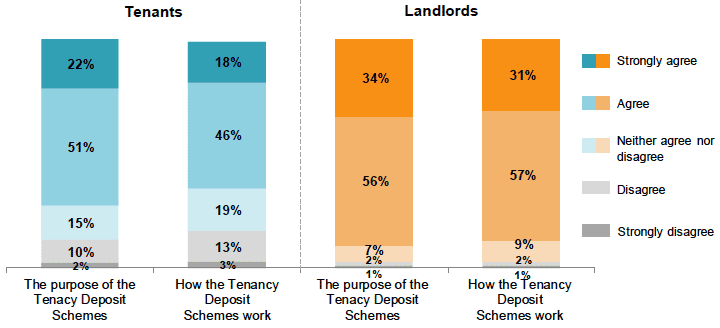
Base: all tenants (7969) all landlords (1087)
Tenant subgroup differences
Older households were the most likely household type to agree that they knew enough about the purpose of the tenancy deposit schemes (83%), whilst large adult households were the least likely type to agree with this statement (63%)[2]. Similarly, older households were also the most likely to agree that they knew enough about how the tenancy deposit schemes work (79%) and again large adult households were least likely to agree (56%)[3].
Tenants in small town and rural areas were more likely than those in urban areas to agree that they knew enough about the purpose of the tenancy deposit schemes (both 79%, compared with 74%). Tenants in urban areas were also more likely to disagree with this statement (13%, compared with 7% for both rural and small town areas). Similarly, tenants in small town and rural areas were more likely to agree that they knew enough about how the tenancy deposit schemes work (73% and 71% respectively, compared with 66% of those in urban areas). Tenants in urban areas were more likely to disagree with this statement (17%, compared to 9% for both small town and rural areas).
Tenants who did not rent through a letting agent were more likely to agree that they know enough about how the tenancy deposit schemes work (68%, compared with 65% of those who did rent through a letting agent).
Landlord subgroup differences
Longer-term landlords were also more likely than newer landlords to agree that they 'know enough about how the schemes work' (91%, compared with 85%)
Perceptions of the tenancy deposit scheme regulations - landlords
Landlords were also asked whether they agreed with a number of other statements about the tenancy deposit scheme regulations. As shown in Figure 2, the vast majority of landlords agreed that the tenancy deposit scheme regulations 'are good for tenants' and 'ensure that deposits are safeguarded'. More than half of landlords agreed that the regulations 'are good for landlords', 'ensure deposits are returned quickly' and 'reduce the number of unfairly held deposits'. A substantial minority of landlords did not know whether the regulations 'reduce unfairly withheld deposits' or 'improve standards'.
Figure 2. Whether landlords agree that the tenancy deposit scheme regulations…
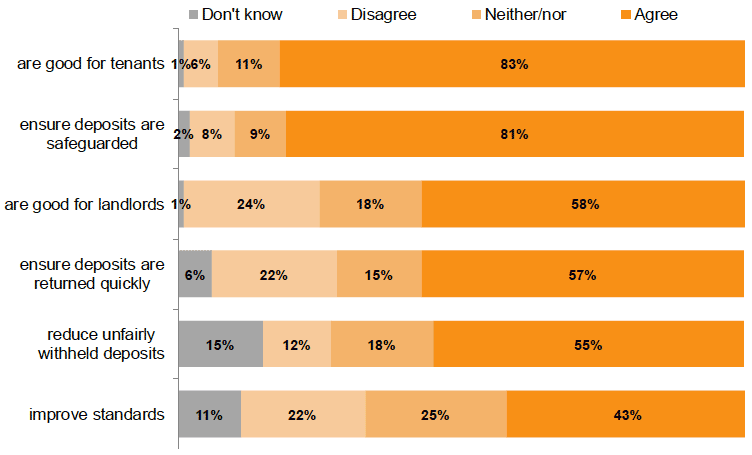
Base: all landlords (1087)
Landlord subgroup differences
There were a number of differences in attitude across different subgroups of landlords. In general those who were longer-term landlords were less positive about the regulations than newer landlords, as were landlords with more than one rental property (compared to those with more than one).
Landlords with just one rental property were more likely (than landlords with multiple properties) to agree that the regulations:
- are good for landlords (62%, compared with 54%)
- ensure deposits are safeguarded (83%, compared with 78%)
Whereas landlords with more than one rental property were more likely (than landlords with just one rental property) to disagree that the regulations:
- are good for landlords (27%, compared with 21%).
- improve standards (26%, compared with 17%)
- ensure deposits are returned quickly and fairly (25%, compared with 19%).
Newer landlords were more likely (than longer-term landlords) to agree that the regulations:
- are good for landlords (67%, compared with 51%)
- reduce unfairly held deposits (63%, compared with 50%)
- ensure deposits are safeguarded (87%, compared with 76%)
- ensure deposits are returned quickly and fairly (65%, compared with 52%).
Whereas longer-term landlords were more likely (than newer landlords) to disagree that the regulations:
- are good for landlords (30%, compared with 14%)
- are good for tenants (8%, compared with 2%)
- reduce unfairly held deposits (15%, compared with 7%)
- ensure deposits are safeguarded (11%, compared with 5%)
- ensure deposits are returned quickly and fairly (27%, compared with 15%).
Opinions of the tenancy deposit schemes - landlords
Those who had been landlords since before 2014 or earlier were asked whether they had a positive, neutral or negative opinion of tenancy deposit schemes when they were introduced in July 2012. All landlords were then asked again whether they had a positive, neutral or negative opinion of tenancy deposit schemes now (in 2018). As shown in Figure 3, 41% of those who became a landlord before 2014 recalled feeling positive about the tenancy deposit scheme when it was introduced. Around a third (34%) felt neutral and 21% felt negative. Figure 3 also shows how those who became a landlord before 2014 felt about the tenancy deposit schemes now. Just over half now felt positive and a quarter felt neutral. However, a similar proportion still felt negative.
Figure 3. How those who had been landlords since before 2014 felt about the tenancy deposit schemes upon introduction (2012) and now (2018)
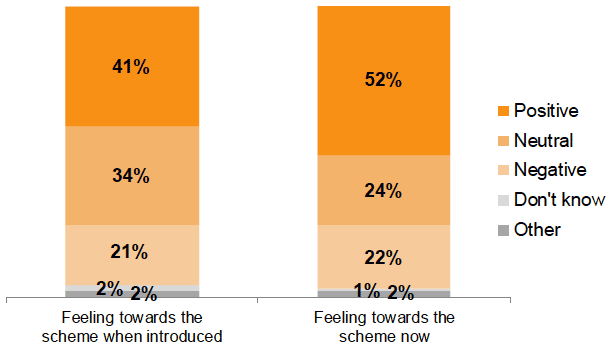
Base: those who became a landlord before 2014 (799)
When all landlords are included, 55% felt positive towards the tenancy deposit scheme now, whilst 24% felt neutral and 19% felt negative.
Landlord subgroup differences
Unintentional landlords were more likely than intentional landlords to have had a positive view of the tenancy deposit schemes when they were introduced (47%, compared with 38%). However, they appeared less likely than intentional landlords to have a positive opinion of the tenancy deposit scheme in 2018 (52%, compared with 58%). Similarly, intentional landlords appeared to have experienced a greater change in opinion between 2012 and 2018, with a 20 percentage point increase in those who felt 'positive' compared with 5 percentage points for unintentional landlords.
Newer landlords were more likely to have a positive view of the tenancy deposit schemes when they were introduced and in 2018 (49% and 64%), compared with longer-term landlords (39% and 50%). Newer landlords were also less likely to have a negative view (9%, compared with 24% in 2012 and 11%, compared with 23% in 2018). Both newer and older landlords appeared to have experienced a change in opinion between 2012 and 2018, with a 15 and 11 percentage point increase in those who felt 'positive' respectively.
Unclaimed deposits - tenants
Tenants and landlords were both asked questions on the topic of unclaimed deposits, however specific questions asked to tenants and landlords differed. Unclaimed deposits occur where a tenant could claim all or some of their deposit money back at the end of the tenancy but does not. These deposits continue to be protected by the schemes and the Scottish Government is exploring how best to deal with this issue.
Tenants were asked whether they, or anyone they knew, had ended a tenancy in the last 5 years without reclaiming the deposit. The vast majority of tenants (85%) had not experienced this themselves and did not know someone who had.
Older households were more likely to have not experienced this or know someone who had (93%, compared to 84-85% of other household types)
Unclaimed deposits - landlords
Landlords were asked whether they were aware of any reasons why tenants, or particular groups of tenants, might not claim back their deposit, and what those reasons might be. The majority of landlords (79%) did not know of a reason tenants might not claim their deposit back.
Landlords were then asked whether they would object to unclaimed deposits being reinvested in the private rented sector in Scotland after 5 years. Just over half would not object to the money being used in this way, whilst a small proportion were unsure what 'reinvested in the private rented sector' would mean in practice and wanted further information (see Figure 4). Some landlords objected to the money being used in the suggested way, but did not give an alternative suggestion for its destination. Perhaps unsurprisingly, the most popular suggestion was to give the unclaimed money to the landlord of the property. However, other suggestions tended to be around using the money to benefit others, such as homelessness or housing charities, other charitable or worthwhile causes and social or affordable housing. A small minority did not think that the 5 year period was long enough, and 1% wanted to reinvest the money in the tenancy deposit scheme system.
Figure 4. Whether landlords object to the unclaimed monies being reinvested in the PRS, and alternative suggestions given
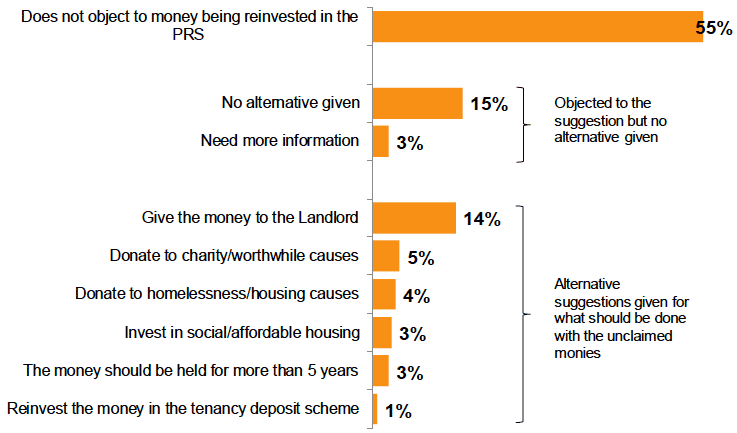
Base: all landlords (1087)
Landlord subgroup differences
Unintentional landlords were more likely to object to the money being reinvested in the private rented sector (52%, compared with 44% of intentional landlords).
Current tenancies - taking and protecting deposits
Taking a deposit - tenants and landlords
All tenants were asked whether they had paid a deposit at the beginning of their current tenancy to either their landlord or letting agent. Almost all tenants in the survey reported that they had paid a deposit[4]. The majority (68%) paid a deposit to their letting agent, whilst a further 29% paid a deposit to their landlord directly.
All landlords who currently had tenants in one or more of their rental properties were asked whether they had taken a deposit[5]. Those who had not taken a deposit were then asked why they had not done so. Finally, landlords who had not taken a deposit and had multiple rental properties were asked if they had taken a deposit for these other tenancies. However, only 31 of all landlords surveyed had not taken a deposit for their current tenancy, and so further analysis could not be conducted.
Protecting a deposit - tenants
Tenants were asked whether their deposit is protected by one of the tenancy deposit schemes and, if so, which scheme. The vast majority of tenants (91%) reported that their deposit was protected, whilst 1% did not think that their deposit was protected. The remaining 8% did not know if their deposit was protected or not.
Tenant subgroup differences
Large adult households were the most likely not to know if their deposit was protected (12%, compared with 5-9% of other household types).
Tenants in urban areas were more likely not to know if their deposit was protected (9%, compared with 5% for both small town and rural).
Protecting a deposit within 30 days - tenants
Tenants whose deposit had been protected were then asked if their deposit was protected within 30 days, with 68% reporting that it had been. Only 4% reported that their deposit had not been protected within 30 days, with 27% unable to remember.
Those whose deposit had not been protected within 30 days were asked if they had to take any action to get it protected. For the majority, 68%, no action was required. Those who did take action either asked their landlord (13%), their letting agent (13%) or someone else (3%). Just three tenants (1%) applied to the First-tier Tribunal.
Tenant subgroup differences
All other household types were more likely than older households not to know if their deposit had been protected within 30 days (26%-31%, compared with 15%). Tenants who did not use a letting agent were also more likely not to know if their deposit had been protected within the timeframe given (30%, compared with 21% of those who used an agent).
Those in urban areas were more likely than those elsewhere not to know if it had been protected within this timeframe (27%, compared with 24% of small town and 19% of rural). Perhaps unsurprisingly, those whose tenancy began before 2017 were also more likely not to know whether their deposit had been protected within 30 days (31%, compared with 24% of those whose tenancy started more recently).
Protecting a deposit - landlords
Landlords were asked whether their tenants' deposit is protected by one of the tenancy deposit schemes and, if so, which scheme they chose and whether this was done within 30 days. Only nine landlords reported that they had not protected their tenants' deposit.[6] Of those who had protected the deposit, almost all (96%) reported that they had done so within 30 working days.
Scheme - tenants
Nearly half of the tenants surveyed (48%) said their deposit was with SafeDeposits, whilst 20% and 9% said their deposits were with MyDeposits Scotland and Letting Protection Service Scotland respectively. Notably, of those tenants whose deposit had been protected, nearly a quarter (24%) did not know with which scheme.
Older households were the most likely not to know which scheme their deposit was protected with, especially compared with small and large adult households (30%, compared with 22% and 23% respectively). Those whose tenancy began before 2017 were also more likely not to know who their deposit was protected with (28%, compared with 21% of those whose tenancy started more recently).
Choice of scheme - landlords
Landlords were then asked how they chose which scheme to use and why. Over half (55%) had chosen SafeDeposits, 31% were with MyDeposits and 13% with Letting Protection Services Scotland. Only 2% did not know which scheme they were with.
As shown in Figure 5, the most common reason landlords gave for choosing their current scheme was having used it before and were left satisfied. Other popular motivations included 'letting agent suggestion', 'scheme's marketing/promotional materials' and 'where the scheme is based'.
Figure 5. Reasons for landlords' choice of tenancy deposit scheme
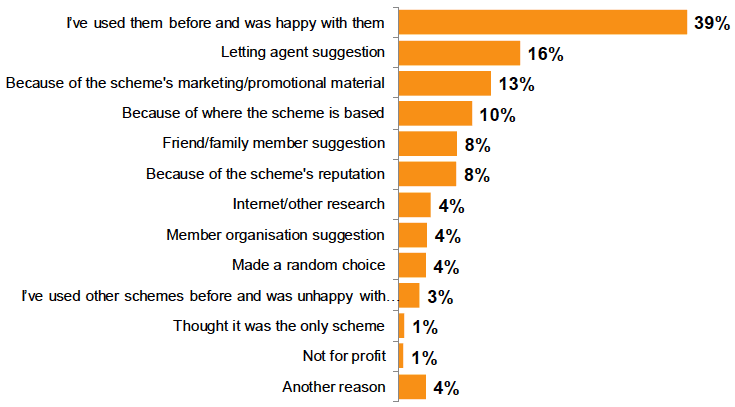
Base: landlords who had protected their tenants deposit (970)
Landlord subgroup differences
There were some differences in reasons for choosing a scheme by different landlord subgroups.
Landlords with one property were less likely to choose because they have 'used them before and been happy with them' (36%, compared with 42% of landlords with more than one property).
Landlords with properties in small towns were more likely to choose a scheme based on 'letting agent suggestion' (21%, compared with 14% of both rural and urban landlords).
Newer landlords were more likely than longer-term landlords to choose a scheme for the following reasons:
- letting agent suggestion 20%, compared with 14%
- family/friend suggestion 13%, compared with 5%
- because of scheme's reputation 10%, compared with 6%
Newer landlords were less likely than longer-term landlords to choose a scheme because they had used it before and were happy (33%, compared with 43%).
Unprotected deposits - tenants
Tenants whose deposits were not protected were asked what actions, if any, they had taken as a result. Only 68 tenants reported that their deposit was not protected, and so further analysis cannot be completed.
However, tenants were also asked whether they had had a tenancy in the last 5 years where the deposit had been unprotected, including their current tenancy. Nearly a fifth (19%) of tenants had experienced this, with another 9% unable to recall.
Tenant subgroup differences
Family households were the most likely to have had a tenancy in the last 5 years where the deposit was unprotected (22%), especially compared to single adult (18%), large adult (16%) and older (15%) households.
Information, complaints and contact
Whether and what types of information about schemes received - tenants
As shown in Figure 6, tenants were most likely to have received information about which scheme is protecting their deposit, followed by the purpose of the tenancy deposit schemes. A much smaller proportion had received information about what happens if there is a disagreement over how much of their deposit should be returned, or how to make a complaint.
Figure 6 Information tenants had received about the tenancy deposit scheme
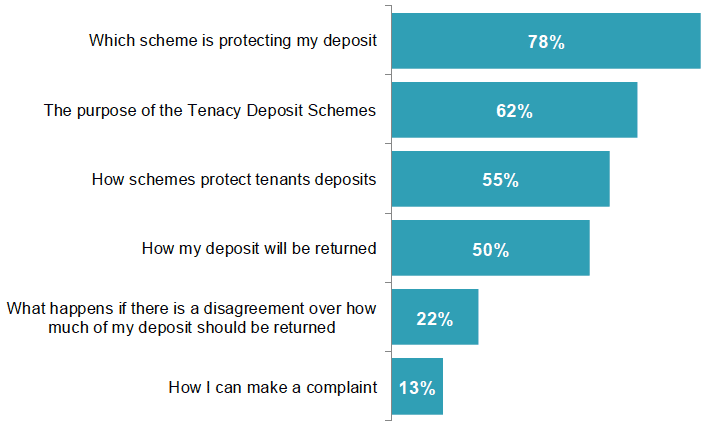
Base: tenants whose deposit was protected (7793)
Tenant subgroup differences
Older households were more likely to have received information about how tenancy deposit schemes protect tenant's deposits (72%, compared with 51-55% of other household types) and how to make a complaint (26%, compared with 10-14% of other household types).
Tenants who rented through a letting agent were more likely to have received information about the purpose of tenancy deposit schemes (64%, compared with 57% of those who did not use a letting agent).
Those whose tenancy began in 2017 or later were more likely (than those whose tenancy began earlier) to recall having received information about:
- which scheme is protecting the deposit (82%, compared with 73%)
- how the deposit will be returned at the end of the tenancy (53%, compared with 46%)
- what happens if there is a disagreement over how much of the deposit should be returned at the end of the tenancy (25%, compared with 17%).
How information was received - tenants
Tenants were also asked how they received information about the tenancy deposit scheme and could choose more than one answer.
Tenants were most likely to receive information from their letting agent (52%) or directly from the scheme (49%). Just over a fifth (21%) had received information from their landlord and 9% had found information for themselves on the scheme's website.
Tenant subgroup differences
All other household types were more likely to have accessed the schemes website to receive information than older households (8-11%, compared with 3%).
Rural tenants were more likely to have received information from their landlord (28%, compared with 19% of urban and 17% of small town tenants), whereas urban tenants were more likely to have received information from their letting agent (56%, compared with 50% of small town and 39% of rural tenants).
Those whose tenancy began in 2017 or later were more likely to have received information from their letting agent (54%, compared with 50% of those whose tenancy began earlier).
Further information needed - tenants
Tenants were also asked what information they would like to receive. Although 61% did not need further information, those that did were most likely to want information about 'what happens if there is a disagreement over how much of the deposit should be returned', followed by 'how my deposit will be returned' and 'how I can make a complaint' (see Figure 7).
Figure 7. What information types tenants have not received information about but want to
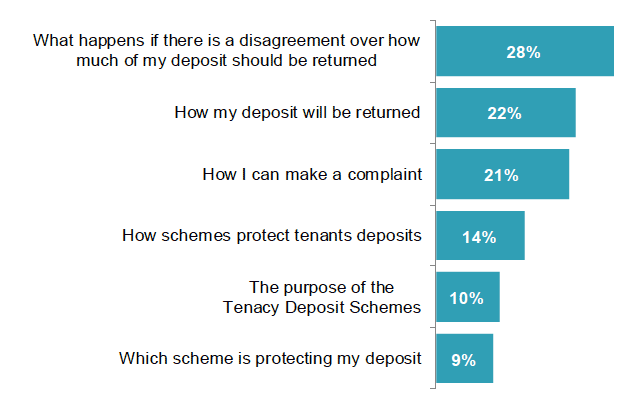
Base: tenants who had received information from the scheme (5957)
Tenant subgroup differences
Older households were more likely than other household types to not require any further information about tenancy deposit schemes (72%, compared with 52-63%).
Satisfaction with information received - tenants
Tenants were asked how satisfied they were with the amount of information they received. The majority were satisfied with the information they had received, with 36% 'very satisfied' and 38% 'fairly satisfied'. Only a small proportion were dissatisfied overall with the amount of information received.
Figure 8 Satisfaction with amount of information received about the scheme
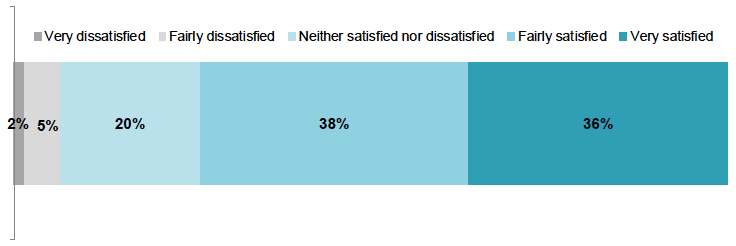
Base: tenants who had received information from the scheme (6425)
Tenant subgroup differences
Older households were more likely to be satisfied with the amount of information they received (84%, compared with 67-75% of other household types). Those that did not use a letting agent were also more likely to be satisfied with the amount of information they received (76%, compared with 73%). Tenants in small towns were more likely to be satisfied with the amount of information received, especially compared with those in urban areas (81%, compared with 74%)[7]. Finally, those whose tenancies began in 2017 or later were also more likely to be satisfied than those whose tenancies began earlier (77%, compared with 71%).
Complaints - tenants and landlords
Tenants and landlords were asked whether they had complained about the scheme and who they had complained to.
Only 67 tenants (1%) and 34 landlords (4%) had made a complaint about their current tenancy deposit scheme. This means further analysis is not possible.
Contact - tenants and landlords
Tenants and landlords were asked whether they had contacted the tenancy deposit scheme (other than to complain), and 261 tenants (4%) and 189 landlords (20%) had done so.
As shown in Figure 9, the majority of both tenants and landlords who had contacted the schemes agreed that it had been easy to do so. Landlords were slightly more likely to 'strongly agree' with this than tenants.
Figure 9. Whether tenants and landlords agree that it was easy to contact the scheme
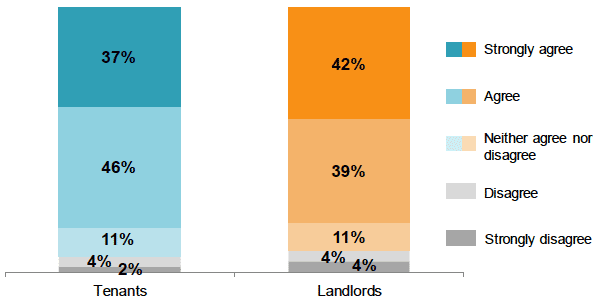
Base: tenants who had contacted the scheme (255) landlords who had contacted the scheme (189)
The most common reason for tenants contacting the scheme was to find out how to claim back their deposit (52%). Tenants also contacted the scheme to check their deposit was protected (31%) and to find out how to log in to their account (28%). Tenants also contacted the scheme to find out how to dispute an offer (18%), to get information on how the scheme works (17%) and to find out how to complain (3%).
For landlords, the most common reasons for contacting the scheme were 'to get information on how the scheme worked (27%), to find out how to make deductions from the deposit (25%). Landlords also contacted the scheme to find out how to log in to their account (15%), to check that the tenant's deposit was protected (12%) and to find out how to dispute an offer (11%).
Performance of the schemes during the tenancy (current tenancies)
Satisfaction with scheme - landlords
Landlords were also asked how satisfied they were with their current scheme. The majority were satisfied with their current scheme, with 43% 'very satisfied'. A minority (10%) were dissatisfied with the scheme.
Landlord subgroup differences
Landlords with more than one property were more likely be dissatisfied with their chosen tenancy deposit scheme (13%, compared with 7% of those with only one property).
Intentional landlords were more likely to be satisfied with their chosen scheme (71%, compared with 65% of unintentional landlords).
Longer-term landlords were more likely to be dissatisfied with their chosen scheme (12%, compared with 7% of newer landlords).
Reasons for satisfaction with scheme - landlords
Landlords who were satisfied and dissatisfied were asked why. As shown in Figure 10, those who were satisfied most commonly said it was because protecting their tenants deposit had been easy, and because they have not experienced any issues.
Figure 10. Reasons landlords were satisfied with their chosen tenancy deposit scheme
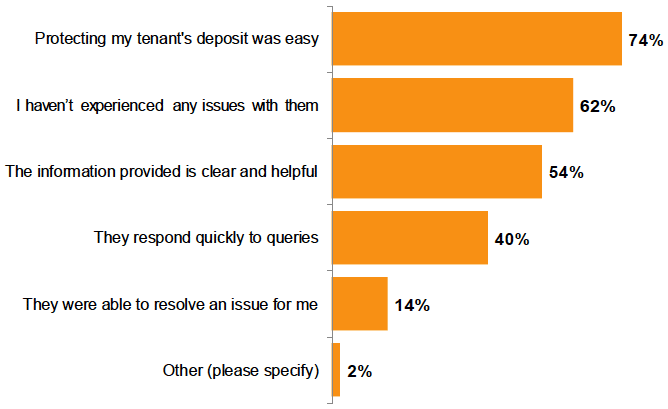
Base: landlords who were satisfied with the tenancy deposit scheme (665)
For those who were dissatisfied, 51% said it was because the scheme was unable to resolve an issue for them. A fifth (20%) were dissatisfied because it was too complicated to protect their tenants' deposit, 17% were dissatisfied because the scheme did not respond quickly enough to queries, whilst for 15% the scheme provided information that was unclear and unhelpful.
Landlord subgroup differences
Landlords with more than one rental property were more likely to be satisfied (compared with those with one property) because the scheme 'responds quickly to queries' (47%, compared with 32%) and was 'able to resolve an issue for me' (17%, compared with 11%).
Intentional landlords were more likely to be satisfied because the scheme responds quickly to queries (48%, compared with 28% of unintentional landlords).
Longer-term landlords were also more likely to be satisfied because the scheme responds quickly to queries (44%, compared with 35% of newer landlords).
Switching scheme - landlords
Landlords were asked whether they were planning to switch scheme, either during or at the end of the current tenancy. A very small minority (1%) intended to switch during this tenancy, and a further 3% planned to do so at the end of the tenancy. However, 10% (93 landlords) did not know whether they would change scheme in the future.
Confidence and trust - tenants and landlords
Tenants were asked how much they agreed or disagreed with the following statements:
- I am confident that my tenancy deposit is safe
- I trust the tenancy deposit scheme to deal with my deposit fairly and efficiently.
Similarly, landlords were asked how much they agreed or disagreed with similar statements:
- I am confident that my tenant's deposit is safe
- I trust the tenancy deposit scheme to deal with my tenants deposit fairly and efficiently.
As shown in Figure 11, the vast majority of tenants (90%) agreed that they felt confident that their deposit was safe. However, 10% of the tenants did not agree that they felt confident that their deposit was not safe. A similar proportion of landlords agreed that they felt confident that their tenants deposit was safe.
The majority of tenants agreed that they trusted the tenancy deposit scheme to deal with their deposit fairly and efficiently. Again, only 15% disagreed with this statement. However, landlords were less likely to agree and more likely to disagree with the corresponding statement.
Figure 11 Whether tenants and landlords agree with the statements shown
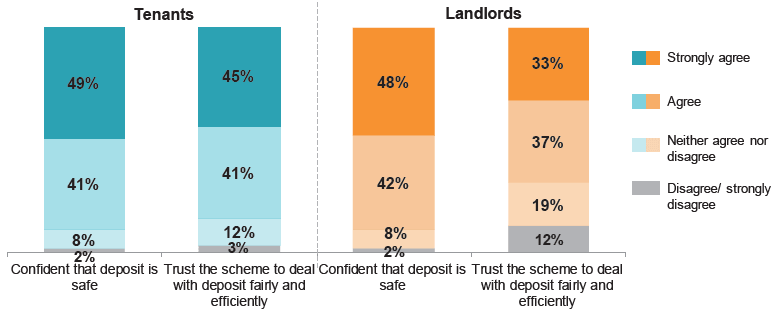
Base: tenants whose deposit is protected (7793) landlords who protected the deposit (970)
Tenant subgroup differences
Older households were the most likely to agree that they were confident their deposit was safe (96%), especially compared with single adult (89%), large adult (89%) and family (88%) households[8]. Older households (91%) and small adult households (89%) were also more likely than single adult (85%) or family (84%) households to agree that they trusted the scheme to deal with their deposit fairly and efficiently[9].
Tenants who did not use a letting agent were more likely to agree with the first statement (confident their deposit was safe) than those who did not use an agent (92%, compared with 89% of those who used a letting agent). Similarly, those who did not use a letting agent were also more likely to agree with the second statement (89%, compared with 84%).
Those whose tenancy began more recently were also more likely to agree than those whose tenancy began before 2017 that they 'trust the tenancy deposit scheme to deal with my deposit fairly and efficiently' - 87%, compared with 84%
Landlord subgroup differences
Intentional landlords were more likely to agree that they were confident that their deposit was safe (92%, compared with 86% of unintentional landlords). Intentional landlords were also more likely to agree that they trust the scheme to deal with their deposit fairly and efficiently (72%, compared with 66%).
Newer landlords were also more likely to agree to trust the scheme to deal with their deposit fairly and efficiently (76%, compared with 66% of longer-term landlords) and less likely to disagree (8%, compared with 14%).
Previous tenancies - Experiences at the end of tenancy
Tenants and landlords were then asked a series of questions about a tenancy that ended in the last 3 years.
Whether deposit returned on time and/or in full - tenants and landlords
As shown in Figure 12, most tenants received their deposit back on time and the majority received their deposit in full. Of those who gave an answer to both questions, 67% received their deposit back on time and in full.
As also shown in Figure 12, similar proportions of landlords reported that their tenants received their deposit back on time and in full. Again, of those who gave an answer to both questions, 63% said their tenants got their deposit back on time and in full.
Figure 12 Whether the tenants deposit was returned on time and/or in full
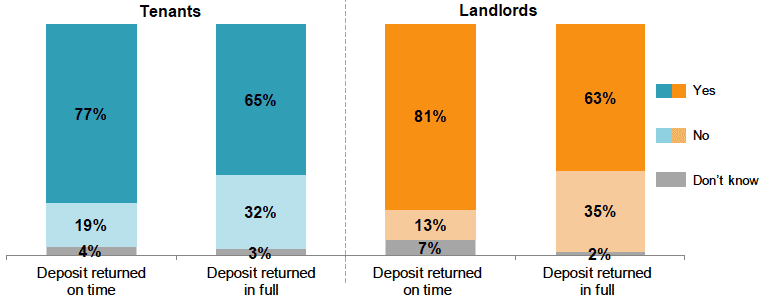
Base: tenants who had a previous tenancy where the deposit was protected (2275) landlords who had a previous tenancy and protected the deposit (810)
Tenant subgroup differences
Older households were more likely to have had their deposit returned on time (95%, compared with 74-77% of other household types), and in full (93%, compared with 52-67%).
Tenants who had not used a letting agent were more likely to have had their deposit returned on time (82%, compared with 75% of those who used an agent) and in full (76%, compared with 61%). Similarly, 77% of those who did not use an agent received their deposit back on time and in full, compared with 63% of those who rented through a letting agent.
Tenants whose previous tenancy ended before 2017 were more likely to have had their deposit returned in full (69%, compared with 63%).
Reasons why deposit not returned on time and/or in full - tenants
Tenants who did not get their deposit back on time were asked why there was a delay. For most tenants, the reason for the delay was most commonly their landlord (54%) or because they were negotiating any deductions to be made (45%). The tenancy deposit scheme caused a delay for 9% of tenants.
Those who did not receive their deposit in full were also asked why this was. The most common reason for deposit deductions was 'damage to the property' (84%), followed by 'rent arrears' (15%) and 'unpaid bills' (2%).
Tenant subgroup differences
Family households were more likely to have not received their deposit back in full because of rent arrears (34%) than single adult (12%), small adult (6%) or large adult (5%) households[10]. On the other hand, family households were less likely to have had deductions made because of damage to the property (64%) than single adult (86%), small adult (94%) or large adult (93%) households.[11]
Reasons why deposit not returned on time and/or in full - landlords
Landlords whose tenants did not get their deposit back on time were asked why there was a delay. Around half of landlords reported that they were negotiating any deductions to be made (52%), for 17% the tenancy deposit scheme caused a delay and for 16% the tenant caused a delay. Only 3% of landlords said that they had caused a delay themselves.
Landlords were also asked why their tenants did not receive their deposit back in full. The most common reasons were damage to the property (66%) and cleaning (63%)[12]. For 29%, the deposit was not returned in full because of rent arrears, while for 11% unpaid bills were the cause.
Dispute process - tenants
Those who did not get their deposit back in full and/or on time were then asked if they used the scheme's dispute process. Of those tenants, 35% had used the dispute process, the remaining 65% had not.
Tenants who did not use the dispute process were asked why they did not so do. As shown in Figure 13, the most common reasons given were that 'the scheme explained why the deposit wasn't being returned in full,' and that they 'did not think the dispute process would make any difference'. A third of tenants said that they did not want to spend time or effort on the dispute process, whilst one in three did not know there was a dispute process.
Figure 13. Reasons why tenants did not use the dispute service
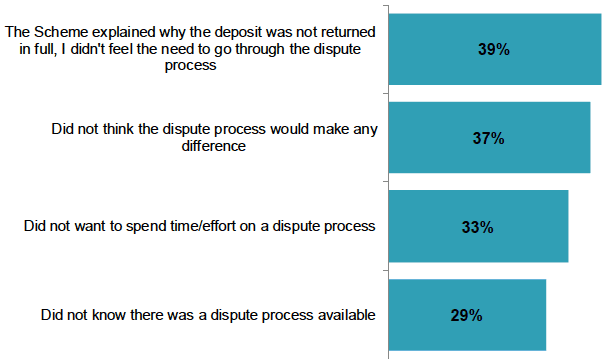
Base: tenants who did not use the dispute service (458)
Tenant subgroup differences
Tenants who rented through a letting agent were more likely to use the tenancy deposit schemes dispute process (37%) than those who did not use a letting agent (25%).
Large adult households were the most likely to not use the dispute service because they did not think it would make any difference (52%), especially compared with family households (26%).
Similarly, those who did not rent their previous tenancy through a letting agent were more likely to have not used the dispute process because they did not think it would make any difference (47%, compared with 34% of those who did use an agent). Conversely, those who did use an agent were more likely to have not used the dispute service because they did not want to spend the time or effort (35%, compared with 22% of those who did not use a letting agent).
Results of the dispute process - tenants
Tenants were asked what the result of the dispute process was, as well as how satisfied they were with the handling and outcome of the process.
Of those who used the dispute service, 20% reported that it found in their favour, whilst for 26% it was found in favour of the landlord and for 44% it was a split decision.
Furthermore, of those that that did use the dispute process, 55% were satisfied with the handling of the dispute and 41% were satisfied with the outcome.
Tenant subgroup differences
Those who had not used a letting agent were more likely to be satisfied with the outcome of their dispute (60%, compared with 38% of those who did use a letting agent).
Dispute process - landlords
All landlords who had a previous tenancy were asked if they had used the tenancy deposit scheme's dispute service[13], and 20% had done so.
Those who did not use the dispute were most likely to say it was because they did not want to spend the time and effort (38%), or because they had agreed an amount separately with the tenant (25%). Landlords also did not use the dispute process because they did not think it would make any difference (18%), they did not know there was a dispute process (17%), or because the scheme explained things and they didn't feel the need to go through the dispute process (11%).
Results of the dispute process - landlords
Of those who used the dispute service, 43% reported that it found in their favour, whilst for 28% it was found in favour of the tenants and for 21% it was a split decision.
Of those landlords that that did use the dispute process, only 39% were satisfied with the handling of the dispute and 37% were satisfied with the outcome.
Review process - tenants and landlords
Only 34 tenants and 40 landlords went to review and therefore no further analysis has been conducted.
Whether treated fairly at end of tenancy
Both tenants and landlords were asked the extent to which they agreed that the tenancy deposit scheme treated them fairly at the end of the tenancy.
As shown in Figure 14, most tenants agreed that they were treated fairly by the scheme at the end of the tenancy. Only a small proportion disagreed with this statement. Landlords, on the other hand, were both less likely to agree and more likely to disagree that they had been treated fairly by the scheme than tenants.
Figure 14. Whether tenants and landlords feel they were treated fairly at the end of the tenancy
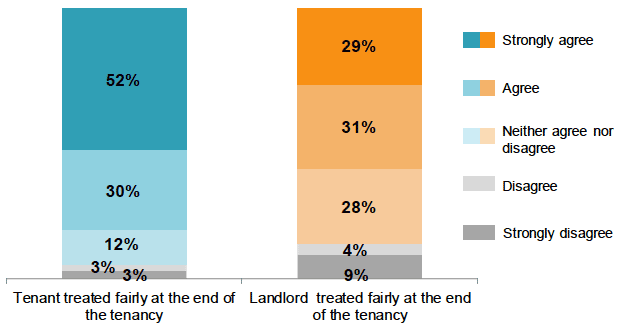
Base: tenants who had a previous tenancy where the deposit was protected (2275) landlords who had a previous tenancy and protected the deposit (810)
Tenant subgroup differences
Older households were more likely to agree that they were treated fairly at the end of the tenancy (97%, compared with 77-82% of other household types).
Those who did not rent through a letting agent were also more likely to agree that they were treated fairly at the end of the tenancy (88%, compared with 80% of those with a letting agent).
Landlord subgroup differences
Unintentional landlords were more likely to disagree that they were treated fairly at the end of the tenancy (15%, compared with 10% of intentional landlords).
Future developments in the Private Rental Sector (PRS)
Awareness of PRS changes - landlords
Landlords were asked how much they knew about some of the recent changes made to the PRS in Scotland.[14]
As shown in Figure 15, landlords knew the most about the new private residential tenancy, with 36% knowing 'a lot' and only 18% not knowing anything. Nearly half of landlords did not know anything about 'letting agent registration' or the 'letting agent code of practices'. The majority of landlords knew nothing about the First Tier Tribunal for Scotland, and only a small proportion knew a lot.
Figure 15. How much landlords know about recent changes made to the PRS
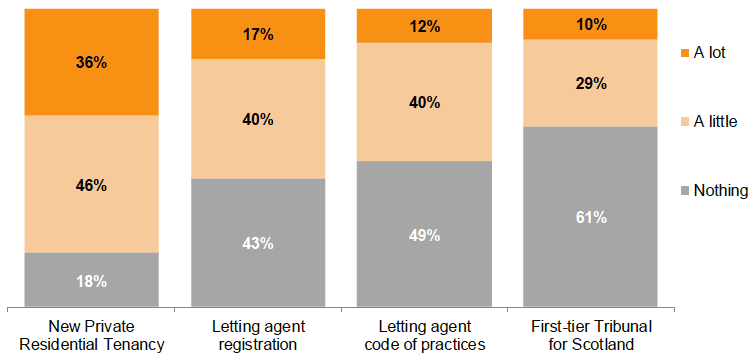
Base: all landlords (1087)
Landlord subgroup differences
Landlords with more than one property were more likely to know 'a lot' about all of the changes to the PRS, compared with landlords who have just one property (Table 2).
Table 2 Proportion of landlords who knew 'a lot' about each PRS change by portfolio size
| PRS change | Landlords with one rental property | Landlords with more than one rental property |
|---|---|---|
| Private residential tenancy | 25% | 46% |
| First tier tribunal | 6% | 14% |
| Letting agent registration | 13% | 21% |
| Letting agent code of practices | 8% | 15% |
Intentional landlords were more likely to know a lot about the new private residential tenancy (40%, compared with 30% of unintentional landlords) and the First Tier Tribunal (12%, compared with 8%).
Longer-term landlords were less likely to know 'nothing' about the private residential tenancy than newer landlords (22%, compared with 16%) and the First Tier Tribunal (58%, compared with 65%).
Intention for rental properties - landlords
Landlords were asked what their plans were for their rental units over the next five years. Almost half were planning to 'keep the same number' (44%), and a further 9% planned to increase the number of units. However, 27% said they were planning to leave the market altogether, whilst 8% planned to decrease the number of units and 13% did not know.
Landlord subgroup differences
Landlords with more than one property were more likely than landlords with only one property to plan to increase the number of units over the next 5 years (12%, compared with 6% of those with one property). Landlords with only one property were more likely to plan to keep the same number of units (49%, compared with 39% of landlords with more than one property) and leave the market altogether (30%, compared with 24%).
Rural landlords were more likely to plan to keep the same number of units than small town or urban landlords (52%, compared with respectively 39% and 46%).
Intentional landlords were more likely to want to increase the number of units (11%, compared with 6% of the unintentional landlords) and to decrease the number of units (11%, compared with 4%). Unintentional landlords were more likely to want to keep the same number of units (48%, compared with 41% of intentional landlords).
Longer-term landlords were more likely to want to decrease the number of units (11%, compared with 3%) and leave the market altogether (32%, compared with 19%). Newer landlords were more likely to want to increase the number of units (14%, compared with 5%) or keep the same number (48%, compared with 41%).
Contact
Email: Sarah Newton
There is a problem
Thanks for your feedback